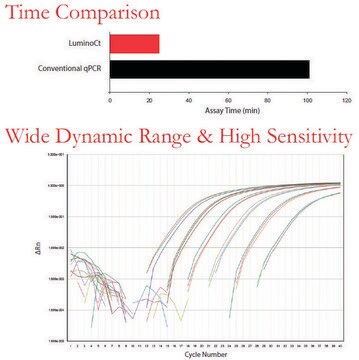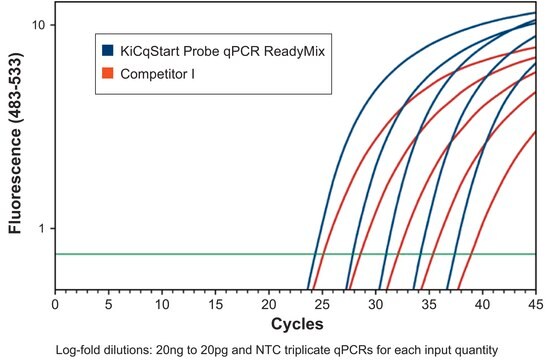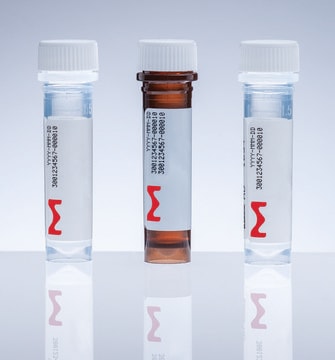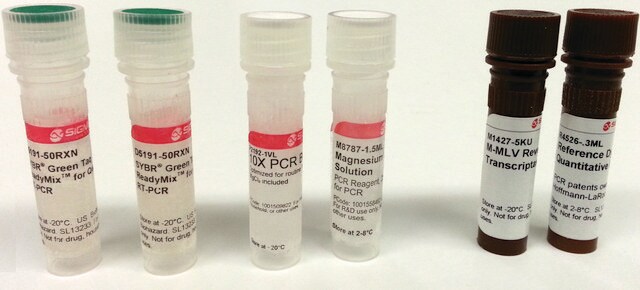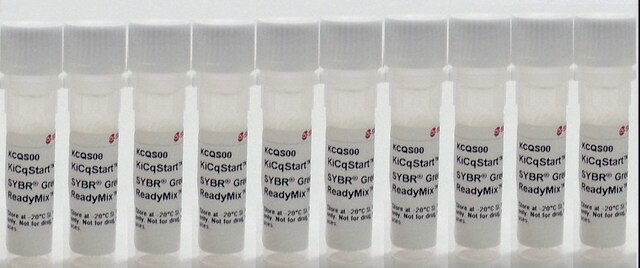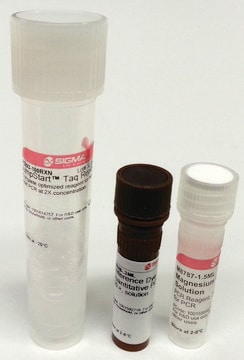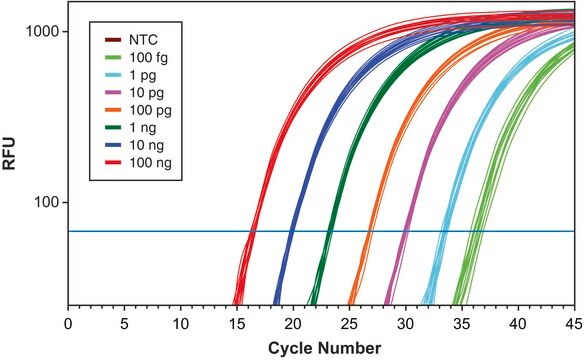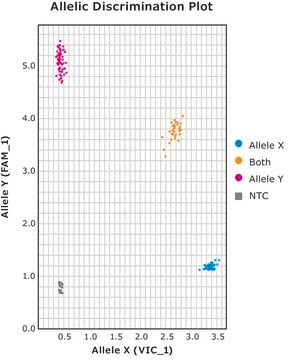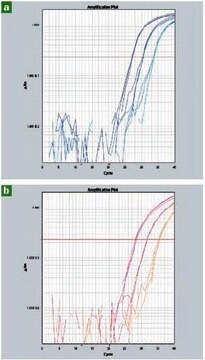L6669
LuminoCt® qPCR ReadyMix™
For fast probe-based quantitative PCR
Synonym(s):
LuminoCt® qPCR ReadyMix™, LuminoCt®
About This Item
Recommended Products
Quality Level
form
liquid
usage
sufficient for 100 reactions
sufficient for 2000 reactions
sufficient for 500 reactions
feature
dNTPs included
hotstart
technique(s)
qPCR: suitable
color
colorless
input
purified DNA
suitability
suitable for (quantitative PCR)
application(s)
agriculture
compatibility
Bio-Rad MyiQ ( )
Bio-Rad iCycler iQ
Bio-Rad iQ 5
for use with ABI 5700
for use with ABI 7000
for use with ABI 7300
for use with ABI 7500 Fast
for use with ABI 7500
for use with ABI 7700
for use with ABI 7900 Fast
for use with ABI 7900 HT
for use with ABI 7900
for use with ABI StepOne
for use with ABI StepOnePlus
for use with ABI ViiA 7
for use with Bio-Rad CFX384
for use with Bio-Rad CFX96
for use with Bio-Rad MJ Chromo4
for use with Bio-Rad MJ Opticon 2
for use with Bio-Rad MJ Opticon Cepheid SmartCycler
for use with Bio-Rad MJ Opticon
for use with Bio-Rad MiniOpticon
for use with Eppendorf® Mastercycler ep realplex2 s
for use with Eppendorf® Mastercycler ep realplex
for use with Illumina Eco qPCR
for use with Qiagen Corbett Rotor-Gene 3000
for use with Qiagen Corbett Rotor-Gene 6000
for use with Qiagen Corbett Rotor-Gene Q
for use with Roche LightCycler 480
for use with Strategene Mx3000P
for use with Strategene Mx3005P
for use with Strategene Mx4000
detection method
probe-based
shipped in
wet ice
storage temp.
−20°C
General description
- Kit is designed to perform probe-based qPCR assays on commonly available real-time instrument platforms.
- ReadyMix requires the addition of reference dye (provided in kit) when being used on real-time instruments that require ROX passive reference dye for normalization of qPCR assays.
- Kit is not compatible with qPCR instruments that utilize glass capillary tubes.
Application
Features and Benefits
- Assay results in as little as 25 minutes
- Designed to deliver unsurpassed accuracy, precision, and sensitivity
- Extensive design and validation of ReadyMix chemistry virtually eliminates the need to optimize assay parameters
- Ideal for rapid, high-throughput 2-step qPCR protocols
- The master mix allows consistency and reproducibility from one reaction to the next
- Reduced preparation time and the risk of contamination from multiple pipetting steps
- Compatible with commonly available real-time instrument platforms for probe-based qPCR assays
- Require small amplicons (<200 bp) for optimal results
- Compatible with commercial primer sets, including TaqMan® assays
- JumpStart™ Taq DNA polymerase allows room temperature set-up and the hot-start mechanism prevents primer-dimer and non-specific product formation
Packaging
100x ROX internal reference dye, Catalog Number R4526. Optional, for use with machines compatible with an internal reference dye, e.g., ABI and Stratagene.
Default reaction volume is 50 μL
100RXN is packaged as 1 X 2.5 mL
500RXN is packaged as 1 X 12.5 mL
2000RXN is packaged as 1 X 50 mL
Other Notes
- Commercially available 5′ nuclease assays (e.g., TaqMan® Assays) are compatible with LuminoCt ReadyMix.
- At a minimum, use software to design primers and probes for assays and ensure that qPCR amplicons are <200 bp.
- Sigma recommends designing primers and probes with Beacon Designer software
To order primers and probes from Sigma, visit www.sigma.com/oligos
Legal Information
Kit Components Also Available Separately
- R4526100X ROX internal reference dyeSDS
related product
Storage Class Code
10 - Combustible liquids
WGK
WGK 1
Regulatory Listings
Regulatory Listings are mainly provided for chemical products. Only limited information can be provided here for non-chemical products. No entry means none of the components are listed. It is the user’s obligation to ensure the safe and legal use of the product.
EU REACH Annex XIV (Authorisation List)
Choose from one of the most recent versions:
Already Own This Product?
Find documentation for the products that you have recently purchased in the Document Library.
Customers Also Viewed
Articles
Probe based QPCR utilizes a fluorescent–labeled target-specific probe resulting in increased specificity and sensitivity. Additionally, a variety of fluorescent dyes are available so that multiple primers can be used to simultaneously amplify many sequences.
A PCR master mix is a batch of PCR or RT-PCR reagents that can be divided among many PCR reaction tubes. It usually includes DNA polymerase, dNTPs, MgCl2 and buffer. Make your own master mix or choose a commercial one.
The polymerase chain reaction is one of the most widely used techniques in molecular biology. The PCR process consists of three main steps, Denaturation, Annealing & Extension
Protocols
The most common application for qPCR is the measurement of a gene transcript or copy number quantity relative to one or more reference genes using probe detection.
A protocol that can be used as a basic template for qPCR incorporating a detection probe that is specific to a single target. In these reactions, primers and probe are included at a final concentration of 200 nM and are run using LuminoCt® ReadyMix™.
Although quantitative PCR uses the same basic concept as traditional PCR, the reactions differ in that the amplicons are generally smaller and are detected indirectly using an additional dye or labeled probe or primer.
The 3’/5’ integrity assay is a potential first step in the identification of RNA degradation. The assay is particularly useful when a large number of samples are to be analyzed or when the degradation is less than that detected by capillary systems but still sufficient to effect qPCR analyses.
Our team of scientists has experience in all areas of research including Life Science, Material Science, Chemical Synthesis, Chromatography, Analytical and many others.
Contact Technical Service